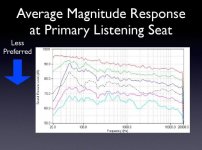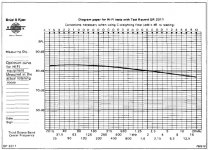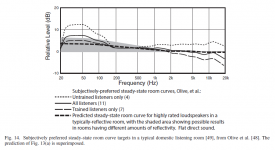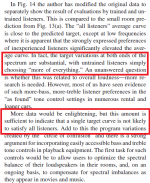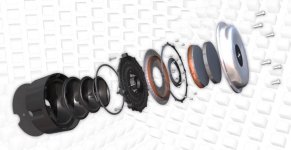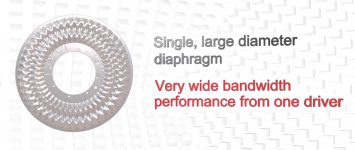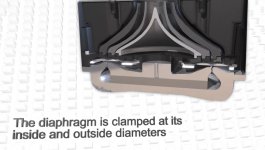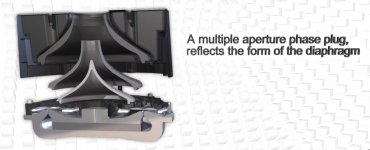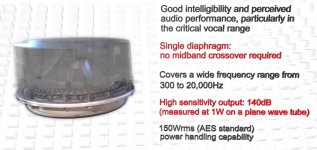I didn't do complete justice to the new driver yesterday when I said it merely remained pistonic over the audible. This quote from the conference paper below claims effective "pulsating sphere" behavior and goes a long way to relieving my fears that as a 2" diaphragm might beam excessively at HF.
"A radial phase-plug, designed according to the
methodology in [2], transforms the acoustical particle
motion from axial diaphragm motion to a close
approximation of a pulsating sphere at the end of the
plug. The waveguide walls are correctly shaped to allow
spherical wave propagation resulting in wider dispersion
and greater output than the original, uncovered dome."
"A radial phase-plug, designed according to the
methodology in [2], transforms the acoustical particle
motion from axial diaphragm motion to a close
approximation of a pulsating sphere at the end of the
plug. The waveguide walls are correctly shaped to allow
spherical wave propagation resulting in wider dispersion
and greater output than the original, uncovered dome."
This project reminds me of a prophetic essay from half a decade ago. In a nutshell, software is becoming so advanced, the difference between the winners and losers in industry is dependent on how good their software is:
Marc Andreessen on Why Software Is Eating the World - WSJ
IE, this looks like a legitimate step forward from Celestion, an achievement that would not have been possible without software.
Marc Andreessen on Why Software Is Eating the World - WSJ
IE, this looks like a legitimate step forward from Celestion, an achievement that would not have been possible without software.
Software took over the world a long time ago. That is yesterday's story. I think Celestion's advancement should be credited to hardware finally become cheap and powerful enough that doing the amount of FEA and BEM computation that was needed became practical. Not all that many years ago, that would have taken a supercomputer.
I wonder what 90x40 2" horn they used for their measurements. Celestion themselves don't have one in their programme.
Regards
Charles
Regards
Charles
May be this one? 😉
An externally hosted image should be here but it was not working when we last tested it.
May be this one? 😉
That appears to be an SEOS-24 from DIY Sound Group, which is not an exponential horn:
Fiberglass SEOS-24™ DIY Sound Group
Last edited:
What interests me, is celestion say it needs no Xover ! Of course it's not a piezo, so what's going on ?
Not exactly. What the spec sheet says is:
No midrange crossover required, leading to improved performance across the crucial vocal audio band, for superb intelligibility
Meaning you don't need to pass from one driver to another in the 1-3kHz range, which is true, but you still very much need a high-pass filter, and probably some EQ work as well to get the top octave to behave.
That appears to be an SEOS-24 from DIY Sound Group, which is not an exponential horn:
Fiberglass SEOS-24™ DIY Sound Group
That was ironic.
I am sure they've tested this driver with a wide range of horns/waveguides in the lab.
Not exactly. What the spec sheet says is:
Meaning you don't need to pass from one driver to another in the 1-3kHz range, which is true, but you still very much need a high-pass filter, and probably some EQ work as well to get the top octave to behave.
This driver is meant for pro audio purposes, it's power rating is impressive and it's very sensitive, so enough. Judging from the curves, it does have potential for a 2-way, not for 50.000 Hz fetishists though. Looking forward to the first M2 killer, based on this driver in a big WG + 18" 😀
Last edited:
Ro:
Interesting perspective. 🙂 I just don't think it needs much EQ, it would be totally worthwhile I think.
You'll almost certainly have to pad it down somewhat, so adding a little top level EQ should be simple.This could be a top notch studio monitor or home theater driver.
Also, covering such a wide range, you probably get amazing impulse response out of it!
Best,
E
Interesting perspective. 🙂 I just don't think it needs much EQ, it would be totally worthwhile I think.
You'll almost certainly have to pad it down somewhat, so adding a little top level EQ should be simple.This could be a top notch studio monitor or home theater driver.
Also, covering such a wide range, you probably get amazing impulse response out of it!
Best,
E
Last edited:
That's what crossed my mind. This driver appears to constitute serious potential for domestic use. I very much like the idea of 1 driver with 1 diaphragm covering 300Hz and up, but who doesn't?
I guess, you're right about the amount of padding and EQ needed, especially considering some research in the field of "preferred room curves".
I guess, you're right about the amount of padding and EQ needed, especially considering some research in the field of "preferred room curves".
Attachments
Last edited:
I wonder if Celestion woud entertain the idea of a group buy for the diy crowd. Maybe get the AVS forum in on this for a wider audience.
I guess, you're right about the amount of padding and EQ needed, especially considering some research in the field of "preferred room curves".
You have to admit, that's mainly a problem because there are no horns which can provide a linear response over a that huge frequency range, independently from the driver. Just simulate a few such wide band horns with a theoretical, ideal drivers, they all dive more or less at the top and/or narrow down in dispersion. There are only very, very rare cases a driver/horn combination doesn't need any EQing. Most of the times it's done in the crossover if it's passive or in the Controller/DSP if it's active. The BMS coax doesn't do there anything better than the Celestion Axi2050, rather the opposite, you need a lot more crossover parts and it's still not satisfying passive.
Personally I use the B&K curve exclusively.
The last Magico I heard used the B&K "bright" version. Meaning it lifted up the treble 2-3 dB. It was actually really good as a background speaker. Brought out a lot of detail without being harsh.
The last Magico I heard used the B&K "bright" version. Meaning it lifted up the treble 2-3 dB. It was actually really good as a background speaker. Brought out a lot of detail without being harsh.
Last edited:
Just simulate a few such wide band horns with a theoretical, ideal drivers, they all dive more or less at the top and/or narrow down in dispersion. There are only very, very rare cases a driver/horn combination doesn't need any EQing. Most of the times it's done in the crossover if it's passive or in the Controller/DSP if it's active.
EQ might solve the response dive, but it cannot fix the dispersion. Isn't that why in general people don't tend to use 2" drivers for the top end? I wonder if this one does any better in that regard?
You have to admit, that's mainly a problem because there are no horns which can provide a linear response over a that huge frequency range, independently from the driver. Just simulate a few such wide band horns with a theoretical, ideal drivers, they all dive more or less at the top and/or narrow down in dispersion. There are only very, very rare cases a driver/horn combination doesn't need any EQing. Most of the times it's done in the crossover if it's passive or in the Controller/DSP if it's active. The BMS coax doesn't do there anything better than the Celestion Axi2050, rather the opposite, you need a lot more crossover parts and it's still not satisfying passive.
Evidently, horn size vs. loading/narrowing is and will remain a challenge for diaphragms of this size, as is mass breakup above 10Khz.
Unless you'd use a big Horn like the Klipsch K-510 (actually a large WG), the first issue needs some clever and creative engineering.
The breakup/falling response is still there, but much less so compared to the classic big guns (WE 555 and the like) due to..... indeed: clever engineering. If you look at the innards you'll notice some unique features, of which the diaphragm + suspension, the multiple aperture phase plug + waveguide are the most obvious.
Attachments
Last edited:
EQ might solve the response dive, but it cannot fix the dispersion.
That's ofcourse right. The dispersion is dependent mainly on the horn but the driver got its good part on that too. That shows very clearly if different horn/driver combinations are paired, some just don't perform well together. The differences are in the compression chamber and phase correction elements in the driver, despite the claims of every manufacturer, the wave front does not come completely flat and in unison (I had to look that up) out of the driver. On many horn/driver combinations there are also some smaller or bigger edges or steps in the opening where the driver ends and the wavefront enters the hornthroat, that's the most critical part of the horn.
Isn't that why in general people don't tend to use 2" drivers for the top end? I wonder if this one does any better in that regard?
Well, the two main reasons why 2" drivers are rarely used are the horn gets a lot bigger quickly if you want a very low cut off frequency. And you need very large diaphragms to get the compression - which in turn usually can't reproduce that high frequencies clean or detailed because of the higher mass and breakup of the controlled movement of the diaphragm.
EQ might solve the response dive, but it cannot fix the dispersion. Isn't that why in general people don't tend to use 2" drivers for the top end? I wonder if this one does any better in that regard?
Dispersion is mainly a product of phase plug, exit vs. entrance (horn/wg termination). If you manipulate a wave front properly (by FEA optimization) you could achieve remarkable results, within the constraints of physics of course.
What appears to happen in the Axi 2050: the wave front is squeezed into the multiple aperture in a controlled (frequency dependent) manner and (wave)guided towards the exit. It's like an inverse 3-, or maybe 2-fold horn inside a waveguide. This can only be achieved by many hours of modeling and optimization.
Besides, if you look at the diaphragm you'll realize this won't break up in the same way as a traditional full dome dia.
Last edited:
- Home
- Loudspeakers
- Multi-Way
- New Celestion "AxiPeriodic Driver"

